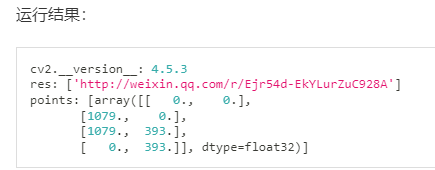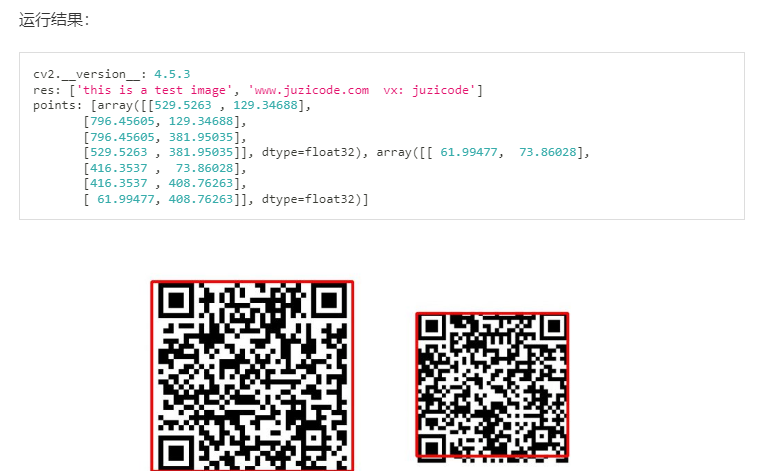原文链接:http://www.juzicode.com/opencv-note-wechat-qrcode-detect-decode
微信开发团队在今年年初的时候将其二维码扫描功能贡献给了OpenCV社区,在OpenCV-Python中也可以使用微信扫码功能了。
使用前需要安装opencv-contrib-python包,注意安装的包不能低于4.5.2版本。
使用起来也非常简单,近乎一行流的风格,首先是用wechat_qrcode_WeChatQRCode()创建检测实例,再用detectAndDecode()检测和识别:
import cv2 print('cv2.__version__:',cv2.__version__) detect_obj = cv2.wechat_qrcode_WeChatQRCode() img = cv2.imread('pic/qr.jpg') res,points = detect_obj.detectAndDecode(img) print('res:',res) print('points:',points)

但是这个时候看到检测到的二维码位置是错误的,那是因为在创建检测实例的时候没有传入模型文件导致的,为了更好的检测精度和检测效果,应该在创建实例的时候传入模型文件,模型文件可以在https://github.com/WeChatCV/opencv_3rdparty/tree/wechat_qrcode 下载到,该链接包含了4个模型文件。

下面的例子是在wechat_qrcode_WeChatQRCode()创建实例的时候传入4个模型文件,注意根据入参名称确定4个模型文件的顺序:
cv2.wechat_qrcode_WeChatQRCode( [, detector_prototxt_path[, detector_caffe_model_path[, super_resolution_prototxt_path[, super_resolution_caffe_model_path]]]] )
import cv2 print('cv2.__version__:',cv2.__version__) detect_obj = cv2.wechat_qrcode_WeChatQRCode('detect.prototxt','detect.caffemodel','sr.prototxt','sr.caffemodel') img = cv2.imread('pic/qr.jpg') res,points = detect_obj.detectAndDecode(img) print('res:',res) print('points:',points) for pos in points:color=(0,0,255)thick=3for p in [(0,1),(1,2),(2,3),(3,0)]:start = int(pos[p[0]][0]),int(pos[p[0]][1])end = int(pos[p[1]][0]),int(pos[p[1]][1])cv2.line(img,start,end,color,thick) cv2.imshow('img',img) cv2.imwrite('wechat-qrcode-detect.jpg',img) cv2.waitKey() cv2.destroyAllWindows()

下面是一张图片中包含多个二维码的情况:
import cv2 detect_obj = cv2.wechat_qrcode_WeChatQRCode('detect.prototxt','detect.caffemodel','sr.prototxt','sr.caffemodel') img = cv2.imread('pic/qr-multi.jpg') res,points = detect_obj.detectAndDecode(img) print('res:',res) print('points:',points) for pos in points:color=(0,0,255)thick=3for p in [(0,1),(1,2),(2,3),(3,0)]:start = int(pos[p[0]][0]),int(pos[p[0]][1])end = int(pos[p[1]][0]),int(pos[p[1]][1])cv2.line(img,start,end,color,thick) cv2.imshow('img',img) cv2.imwrite('wechat-qrcode-detect-multi.jpg',img) cv2.waitKey() cv2.destroyAllWindows()


下面我们来看一下现实场景中的识别效果,从摄像头获取图像并进行解析:
#VX公众号: 桔子code / juzicode.com import cv2 print('cv2.__version__:',cv2.__version__)detect_obj = cv2.wechat_qrcode_WeChatQRCode('detect.prototxt','detect.caffemodel','sr.prototxt','sr.caffemodel') cap = cv2.VideoCapture(0) while cap.isOpened():ret, img = cap.read()if ret is not True:print("读取失败退出")break res,points = detect_obj.detectAndDecode(img)print('res:',res)print('points:',points)for pos in points:color=(0,0,255)thick=3for p in [(0,1),(1,2),(2,3),(3,0)]:start = int(pos[p[0]][0]),int(pos[p[0]][1])end = int(pos[p[1]][0]),int(pos[p[1]][1])cv2.line(img,start,end,color,thick)cv2.imshow('img',img)#检查按键key = cv2.waitKey(200) & 0xffif key == ord('q') or key == ord('Q') :breakcap.release() cv2.destroyAllWindows()
